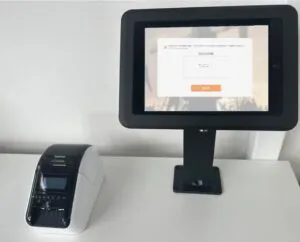Why online inductions and training are here to stay
As we undoubtely know efficiency and compliance are more critical in todays business world than ever. Companies across industries are continuously looking for ways to streamline their onboarding and training processes. Online inductions have emerged as a modern, scalable, and effective solution—one that is not only convenient but also crucial for maintaining consistency, safety and regulatory compliance.
With Induct For Work, businesses can ensure that every new employee, contractor or visitor is trained quickly, efficiently and in alignment with company policies. The benefits of online inductions extend far beyond initial onboarding; they provide long-term value by reducing administrative burden, improving safety awareness and ensuring regulatory compliance.
As technology continues to transform workplaces, traditional face-to-face inductions are becoming less practical. In this article, we’ll explore why online inductions are here to stay, the advantages they bring and Induct For Work make it easier than ever to implement a fast, effective induction process.
The Shift Towards Digital Inductions
The Evolution of Employee Onboarding
Historically, workplace inductions were conducted in person, requiring HR professionals, managers or safety officers to guide new employees through company policies, safety procedures and role expectations. These sessions often involved printed handbooks, PowerPoint presentations and manual paperwork, making the process time-consuming and inconsistent across different locations.
As companies expanded, particularly those with multiple sites or remote teams, in-person inductions became impractical. In recent years this shift accelerated, forcing businesses to rethink traditional training methods. Companies quickly realized that digital onboarding and online inductions could deliver the same—if not better—results with fewer logistical challenges.
1.2. Why Companies Are Making the Switch
Many companies are choosing to continue using online inductions due to the efficiency, cost-effectiveness and compliance advantages they offer. Companies in industries such as construction, manufacturing, healthcare, local government, retail and logistics now rely on online inductions to onboard staff, contractors and visitors with minimal disruption to daily operations.
Induct For Work provides an all-in-one cloud-based solution that allows companies to train employees anytime, anywhere, eliminating the need for classroom-based sessions or time-consuming paperwork.

The Key Benefits of Online Inductions
Convenience & Accessibility
One of the most significant advantages of online inductions is their flexibility. New employees, contractors or visitors can complete their training remotely, at their own pace and on any device. This is particularly beneficial for:
- Remote or hybrid teams who are onboarding from different locations.
- Field-based workers such as construction or transport employees who don’t have access to office training sessions.
- Shift-based workplaces where employees start at different times and cannot always attend group training.
With Induct For Work, online inductions can be accessed via desktop, tablet or mobile, ensuring that all workers, regardless of their location, receive the same high-quality training experience.
2.2. Consistency & Standardisation
One of the biggest challenges with in-person inductions is inconsistency. The quality and depth of training can vary depending on who is delivering it, their teaching style or how much time they have.
With online inductions, every new hire receives the same structured, standardised content. This ensures:
- Accurate and up-to-date information is delivered to every employee.
- No critical safety procedures or policies are overlooked.
- A professional, streamlined experience that reflects company culture.
Using Induct For Work, businesses can easily update induction content, ensuring that any regulatory or company policy changes are instantly reflected in the training materials.
2.3. Compliance & Safety Management
Regulatory compliance is a major concern for businesses, particularly in industries with strict workplace safety requirements. Employers must ensure that workers and contractors are aware of all safety protocols, emergency procedures and industry regulations.
Failing to provide proper induction training can result in:
- Legal penalties or fines due to non-compliance.
- Increased workplace accidents and liability risks.
- Reputational damage if safety standards are not met.
Induct For Work helps organisations stay compliant by automating compliance tracking, storing digital records of completed inductions and ensuring all workers have signed off on key safety procedures before starting their roles.
2.4. Time & Cost Savings
Traditional inductions require HR personnel, trainers or safety officers to conduct repetitive sessions, often spending hours going over the same material for every new hire or contractor. This results in significant costs in terms of lost productivity and labor hours.
With online inductions, businesses can:
- Automate training to reduce the need for in-person sessions.
- Eliminate costs associated with printed materials, travel, and venue hire.
- Free up HR and management teams to focus on more strategic tasks.
Induct For Work allows companies to set up an induction once and deliver it to an unlimited number of employees, making onboarding scalable and cost-effective.
How Induct For Work Simplifies Online Inductions
Easy Setup with Rapid Induction Features
One of the standout features of Induct For Work is its Rapid Induction Setup, which enables companies to quickly create and launch an online induction program without extensive IT support.
With pre-built templates, customisable content and an intuitive user interface, businesses can:
- Upload videos, PDFs and interactive quizzes to enhance engagement.
- Assign different induction modules based on job roles.
- Track employee progress in real-time through a central dashboard.
3.2. Automated Compliance & Record Keeping
Keeping track of who has completed their inductions can be a challenge, particularly in large or multi-site organisations. Induct For Work automates this process by:
- Recording every completed induction in a secure digital database.
- Sending automatic reminders to employees who have not yet completed their training.
- Generating compliance reports that can be used for audits and regulatory checks.
This ensures that no employee, contractor or visitor starts work without meeting their training requirements.
3.3. Seamless Integration with Visitor & Contractor Management
For businesses that frequently work with contractors or visitors, managing inductions manually can be overwhelming. Induct For Work offers a fully integrated visitor management system, allowing organisations to:
- Pre-register contractors and visitors before they arrive on-site.
- Ensure all required safety training is completed online before access is granted.
- Track entry and exit times using digital sign-in tools.
This ensures that every individual who steps onto a worksite is properly inducted and accounted for, reducing risk and enhancing security.

The Future of Online Inductions
With advancements in AI-driven technology and algorythms and mobile-first experiences, the future of online inductions is only getting more advanced. As more companies recognise the benefits of online learning, traditional induction methods are becoming obsolete.
Businesses that adopt digital onboarding and online inductions today will future-proof their training processes, ensuring that new hires, contractors and visitors receive fast, effective and compliant onboarding experiences.
Induct For Work remains at the forefront of this transformation, providing businesses with the tools they need to train employees efficiently, manage compliance effortlessly and scale their induction processes with ease.
Final Words: Online Inductions Are Here to Stay
In today’s fast-paced business environment, traditional induction methods are no longer sufficient. The shift toward online inductions is not a temporary trend but a fundamental change in how businesses train employees, ensure compliance and improve workplace safety.
With Induct For Work, companies can simplify and automate their onboarding, providing a seamless, cost-effective and future-ready solution.
For businesses looking to enhance productivity, reduce risks and create a more streamlined training experience, now is the time to embrace online inductions—because they are here to stay. Contact us today to discuss your induction requirements.
Do you have any questions or great tips to share?
Induct for Work – the only online induction system you would need to run online inductions.



